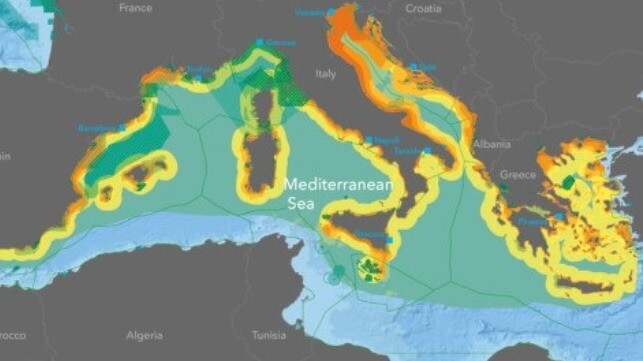“Coexistence of Ocean Space is Essential” DNV Reports

“Coexistence is essential” as DNV report shows demand for ocean space will grow 5-fold by 2050
• Offshore wind will account for 80% of stationary infrastructure at sea by 2050, up from 15% today.
• Europe will experience significant pressure on ocean space with demand particularly strong in North Sea, Celtic-Biscay Shelf and Baltic Sea
• Greater China will build most offshore infrastructure (covering 112,000 square kilometers by 2050), followed by Europe (70,000 square kilometers). Globally, ocean installations will cover 335,000 square kilometers by midcentury, which is larger than the landmass of Poland
• DNV also chosen to lead project to optimize marine spatial planning off coast of Norway
The collaboration between ocean industries will need to intensify for the rapid buildout of offshore wind and aquaculture to coexist sustainably with other industries and the ecosystem. According to DNV’s Spatial Competition Forecast, the amount of ocean space occupied by installations will grow 5-fold by 2050. This will be driven by offshore wind, which will account for 80% of stationary infrastructure at sea by midcentury, followed by aquaculture (13%) and oil and gas (5%).
While ocean space is plentiful, industrial activity will be located primarily close to shore which will heighten the need for ocean coexistence. To enable stakeholders to gauge the demand for ocean space DNV has developed the Spatial Competition Index. According to this index, the North Sea is the area in Europe which will see greatest competition due to the large number of shipping lanes and ports, as well as the strong presences of the fishing, aquaculture, oil and gas and wind industries. Installations for offshore energy and food production will cover 23% of the area between 2-50 km from shore in water depths less than 50 metres.
Greater China’s emergence as the powerhouse of the blue economy is reflected in offshore construction. It will account for a third of all global infrastructure built at sea by 2050, mainly due to the sharp increase in offshore wind, which will make up 13% of the region’s electricity production. The Indian Subcontinent sees the strongest growth in area covered by stationary infrastructure, as the region experiences fast offshore wind development requiring vast areas, whereas historically, offshore oil and gas and marine aquaculture are negligible in this region.
Globally, the area occupied by fixed offshore wind will grow from about 9,000 km2 today to about 242,000 km2 by mid-century. Floating offshore wind will grow from a low 15 km2 today to more than 33,000 km2 by 2050. Compared with bottom-grounded installations, floating offshore wind can potentially ease some of the tensions between offshore wind and fisheries, as it takes renewable energy production out of the way of the fishing fleet operating on shallow banks.
“The ocean is crucial for the production of sustainable food and energy, but at the same time we must tread carefully as many ocean ecosystems are already under huge stress,” said Bente Pretlove, Ocean Space programme director at DNV. “This report underscores the urgent need to balance protection, productivity, and social development objectives for a sustainable Blue Economy. Those developers that are most adept at early stakeholder engagement, spatial efficiency, flexible coexistence, and pursuit of sustainability are likely to be most competitive. Coexistence is essential for the sustainable growth of the Blue Economy.”

DNV’s Spatial Competition Forecast builds on the findings of the previously published Ocean’s Future to 2050. The results are based on what DNV forecasts to be the most likely energy mix in 2050 and not what is required to reach net zero. To limit global warming to two degrees the amount of offshore wind in Europe, for example, would need to double.
DNV to lead research project to strengthen marine and offshore wind coexistence planning
The Norwegian coast will also experience pressure on space with the expansion of offshore wind and aquaculture in coexistence with maritime traffic, fishing vessels and oil and gas infrastructure. To facilitate collaboration between industries and enable stakeholders to find synergies, resolve conflicts and safeguard ocean health, DNV has recently received a grant of NOK 8.8 million from The Research Council of Norway to develop the MARine CO-existence scenario building (MARCO) toolbox. The project aims to establish a common knowledge basis among ocean stakeholders by introducing new ways of generating scenarios for co-existence in marine spatial planning and development projects in the ocean industries.
The Utsira Nord offshore wind licensing area in Norway will act as one of the case studies. The partners include offshore wind developer Mainstream Renewable Power, SalMar Aker Ocean, the Norwegian Institute of Marine Research, and the Norwegian Fishermen’s Association.
-
About DNV
DNV is the independent expert in risk management and assurance, operating in more than 100 countries. Through its broad experience and deep expertise DNV advances safety and sustainable performance, sets industry benchmarks, and inspires and invents solutions.
Whether assessing a new ship design, optimizing the performance of a wind farm, analyzing sensor data from a gas pipeline or certifying a food company’s supply chain, DNV enables its customers and their stakeholders to make critical decisions with confidence.
Driven by its purpose, to safeguard life, property, and the environment, DNV helps tackle the challenges and global transformations facing its customers and the world today and is a trusted voice for many of the world’s most successful and forward-thinking companies.
www.dnv.com
The products and services herein described in this press release are not endorsed by The Maritime Executive.
